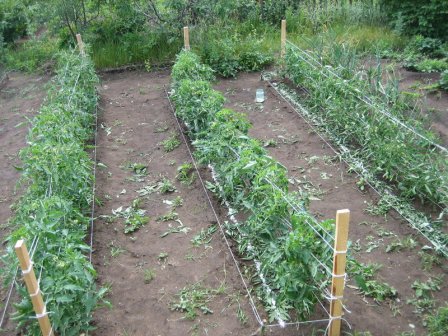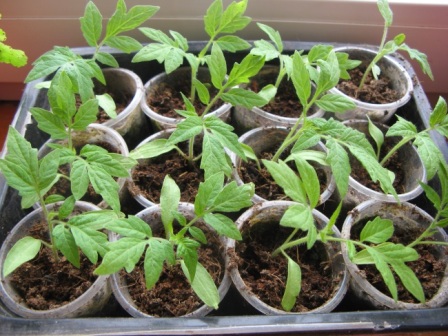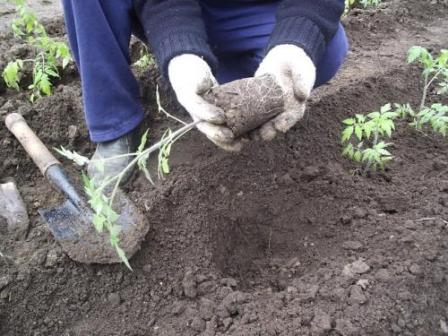 Planting seedlings in open ground has many nuances, which we will consider today. This is choosing the right place for seedlings, and taking into account the predecessors, which plants will be planted nearby, which fertilizers to apply, how to dig holes and water.
Planting seedlings in open ground has many nuances, which we will consider today. This is choosing the right place for seedlings, and taking into account the predecessors, which plants will be planted nearby, which fertilizers to apply, how to dig holes and water.
Site selection
Tomatoes are photophilous plants, and the site must be selected accordingly. The sun and protection from the winds - the main condition. The second, important condition - the soil should not be too wet, with water lying close to the soil, moist low patches - not for tomatoes!
Predecessors are the third important condition for good tomato growth. You can’t plant tomatoes in one place, after potatoes, and it’s very undesirable also near him, this is a direct path to late blight. Good predecessors to tomatoes are root vegetables and legumes. See also, interesting information: Tomathouse.com - how to save your work and time.
Preparation of beds
The beds are treated with copper sulfate (spoon / 10 liters of water). Peat, old manure and ash should be scattered on clay soils, a little superphosphate can be added. Then dig, spill with warm water. Make holes, for better growth, add a solution of "Effekton" to them and proceed with planting.
Planting seedlings and timing

It must be remembered that the seedlings must be fresh. Therefore, the advantage of hand-grown is that it can be immediately transferred from the greenhouse to the open ground, seedlings do not hesitate to wither, which is very important for the subsequent good growth of tomatoes.
- By timing: second half of May for central Russia.
- For the south - from April 15.
- For central areas - from June 1.
You might be interested in: a garden for a bummer who does not dig up all the secrets.
You can plant seedlings in the usual way, vertically, deepening only the roots, leaving the whole stem in the light. It can be planted using the Maslov method, which claims that according to his planting technique, powerful roots are formed that make it possible to get an excellent crop. In this case, the plant is planted reclining, that is, 2/3 of the plant deepens in a horizontal position with ragged leaves, and sprinkled with earth. Moreover, the top should be directed north. Covered in the ground, the stem quickly grows with new roots that strengthen and form a powerful rhizome that can nourish a large bush with many fruits.
Another interesting method of the same Maslov is the digging of stepsons. When the planted plants give the first side stepsons, they should not be removed, and when they are big enough to bend to the ground, sprinkled with a layer of 10 cm. These shoots will give new roots and will soon catch up with the mother plant. They will also have their own stems and fruits, so you can make several from one bush, thereby increasing the amount of yield with a small planting of seedlings. Thus, by the way, many propagate bushes such as currants or gooseberries, then transferring them to a new place. Having prepared the beds, you can proceed with the landing.

Spill the hole with plenty of water, wait until it is completely absorbed, carefully remove the seedlings that you pre-watered, along with a lump of earth, without damaging the roots. Lay the plant at the beginning of the stem, crush the ground, sprinkle a little compost, then sprinkle with earth again, tamp, and spill with water.

That's it, now don’t water the seedlings for a week and a half, let it take root well, calm down and the roots will return to normal. Then water, and after a couple of days you can spud tomatoes.Then water abundantly, but not often, under the root, so that the water is deeply saturated in the ground, then the roots will go down for moisture, and will not become lazy dependents, huddling at the surface and waiting for your next watering. Such roots are stronger, and the plant is stronger and more powerful.
See also: cucumbers in a polycarbonate greenhouse planting and care.




 Low-growing tomatoes, without pinching: 5 of the most delicious varieties
Low-growing tomatoes, without pinching: 5 of the most delicious varieties Why tomato seedlings grow poorly
Why tomato seedlings grow poorly We grow a tomato in a shell
We grow a tomato in a shell Growing tomatoes without watering according to the method of Kazarin
Growing tomatoes without watering according to the method of Kazarin